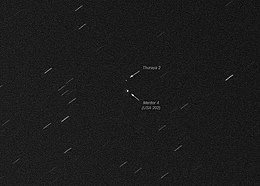cosmos.wikisort.org - Spacecraft
USA 202,[3] previously NRO Launch 26 or NROL-26, is a classified spacecraft which is operated by the United States National Reconnaissance Office. It is an Advanced Orion ELINT satellite. According to Aviation Week, it "fundamentally involves America's biggest, most secret and expensive military spacecraft on board the world's largest rocket."[4] The combined cost of the spacecraft and launch vehicle has been estimated to be over US$2 billion.[4]
 USA 202 and Thuraya 2, photographed on 8 December 2010 from the Netherlands. | |
| Mission type | ELINT |
|---|---|
| Operator | NRO |
| COSPAR ID | 2009-001A |
| SATCAT no. | 33490 |
| Spacecraft properties | |
| Spacecraft type | Orion |
| Start of mission | |
| Launch date | 18 January 2009, 02:47 UTC |
| Rocket | Delta IV Heavy |
| Launch site | Cape Canaveral SLC-37B |
| Contractor | United Launch Alliance |
| Orbital parameters | |
| Reference system | Geocentric |
| Regime | Geosynchronous |
| Longitude | 44° east[1] |
| Perigee altitude | 35,777 kilometers (22,231 mi) |
| Apogee altitude | 35,809 kilometers (22,251 mi) |
| Inclination | 3.69 degrees |
| Period | 23.93 hours |
| Epoch | 1 January 2014, 15:43:08 UTC[2] |

| |
Amateur astronomer observations suspected the satellite was eavesdropping on Thuraya 2 and this was reported to be confirmed by documents released on Sep 9, 2016[5] by The Intercept as part of the Snowden Files.[6]
Launch
USA-202 was launched from Space Launch Complex 37B at the Cape Canaveral Air Force Station, on the third flight of a Delta IV Heavy rocket. The launch was originally scheduled for 2005, but was delayed due to a number of issues, and lift-off took place at 02:47 GMT on 18 January 2009.[7]
References
- "UCS Satellite Database". Union of Concerned Scientists. 1 September 2013. Retrieved 3 January 2014.
- Peat, Chris (1 January 2014). "USA 202 - Orbit". Heavens Above. Retrieved 3 January 2014.
- McDowell, Jonathan. "Issue 605". Jonathan's Space Report. Retrieved 2020-09-01.
- "NRO Delays Delta IV Heavy Launch". Aviation Week. Dec 10, 2008.
- "Documents". The Intercept.
- "The Space Review: A Nemesis in the Sky: PAN, MENTOR 4". The Space Review.
- "First ULA Delta IV Heavy NRO Mission Successfully Lifts Off From Cape Canaveral". ULA. Archived from the original on 2009-02-16.
External links
- Delta IV Heavy NROL-26 - launch information from ULA.
- The USA 202 ORION satellite A technical analysis of the satellite
Другой контент может иметь иную лицензию. Перед использованием материалов сайта WikiSort.org внимательно изучите правила лицензирования конкретных элементов наполнения сайта.
WikiSort.org - проект по пересортировке и дополнению контента Википедии